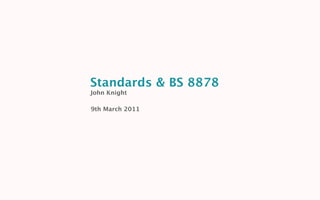Standards - Love 8878
- 1. Standards & BS 8878 John Knight 9th March 2011
- 2. Quick overview ?Examples of standards ?Some problems with standards ?Web standards and accessibility ?Why accessibility is important ?Overview of BS 8878
- 3. Standards make it easier to compare stuff
- 4. Standards support quality assurance
- 5. Standards make the world safer
- 6. Standards make sure things work together
- 7. Standards de?ne - they embody design decisions
- 8. Competing standards are not a good thing
- 9. Multiple standards make things work together
- 10. Standards in the digital world are messy accessibility standards Authoring Tool Accessibility Guidelines (ATAG) BS WAI-TIES Project Reference Accessibility Guidelines 1.0 ISO/IEC DTR 29138-1 ETSI Guide EG 202 116 Web Web Content EG 202 Report Language (EARL) Overview ICT products and services; 116 Guidelines for Initiative: Evaluation and Web Accessibility 'Design 975 All' ES 202 for Harmonized Relay ISO/TS 16071:2003 CEN-CENELEC Guide 6 Training, Implementation, CEN Web Service Userof human-system interaction --(UAAG) Ergonomics Agent Accessibility Guidelines Education, Support services TR 102 974 Telecommunication relay accessibility Guidance on accessibility for human- Overview ETSI TR 102 612 computer interfaces WAI-AGE Project (IST 035015) essibility European accessibility requirements for public IEC Web Accessibility the ICT Initiative: standards WAI-ARIA Overview procurement of products and services in Web Content AccessibilityAgeing Education and Guidelines (WCAG) domain (European Commission Mandate M 376, ISO Three 1) New Accessibility and Web Design Overview Harmonisation (WAI-AGE) andards Phase ES 202 076 User Interfaces; Generic spoken Standards ISO 9241 Parts 20, 151 and Project, European Commission 171 command vocabulary for ICT devices and W3C CEN-CENELEC Guide 6 6th Framework, IST 035015 services
- 11. Technical standards dominate web accessibility Web Content Accessibility Guidelines (WCAG) 2.0 covers a wide range of recommendations for making Web content more accessible. Following these guidelines will make content accessible to a wider range of people with disabilities, including blindness and low vision, deafness and hearing loss, learning disabilities, cognitive limitations, limited movement, speech disabilities, photosensitivity and combinations of these. Following these guidelines will also often make your Web content more usable to users in general. WCAG 2.0 success criteria are written as testable statements that are not technology-specific. Guidance about satisfying the success criteria in specific technologies, as well as general information about interpreting the success criteria, is provided in separate documents. See Web Content Accessibility Guidelines (WCAG) Overview for an introduction and links to WCAG technical and educational material.
- 12. What and why of accessibility Web accessibility refers to the inclusive practice of making websites usable by people of all abilities and disabilities. When sites are correctly designed, developed and edited, all users can have equal access to information and functionality. ? Social Factors addresses the role of Web accessibility in providing equal opportunity for people with disabilities; the overlap with digital divide issues; and benefits to people without disabilities, including older people, people with low literacy and people not fluent in the language, people with low bandwidth connections to the Internet, people using older technologies, and new and infrequent web users. ? Technical Factors addresses interoperability, quality, reducing site development and maintenance time, reducing server load, enabling content on different configurations, and being prepared for advanced web technologies. ? Financial Factors addresses the financial benefits of increased website use, for example, from engine optimization (SEO); direct cost savings; considerations for initial costs and on-going costs; and ways to decrease costs. ? Legal and Policy Factors addresses requirements for Web accessibility from governments and other organizations in the form of laws, policies, regulations, standards, guidelines, directives, communications, orders, or other types of documents.
- 13. BS 8878:2010 Web accessibility. Code of practice ?Process-based standard ?Based on UCD methodology ?Pragmatic and holistic in scope ?Embodies Ą°reasonableĄą approach of DRC
- 14. BS 8878:2010 Web accessibility. Code of practice ?Organisational Web accessibility policy ?Product accessibility policy ?Product accessibility statement
- 15. Love 8878















